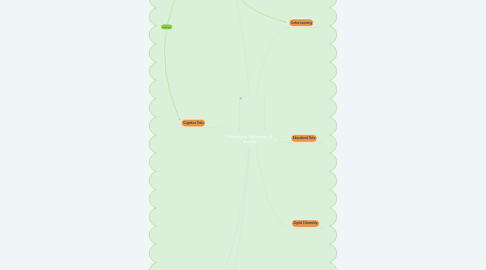
1. Online Learning
1.1. Instructional Videos (Ozdemir et all, 2016)
1.1.1. Do Online Lectures Affect Student Learning? (Kinash, Knight & McLean, 2015)
1.1.2. Video Supported Learning with Elementary Learners (Fößl et al,, 2016)
1.2. Inquiry-Based Learning (Shin et al, 2017)
1.3. MOOCS
1.3.1. Social Mobility (oudeweetering & Agirdag, 2018)
1.3.2. Social Resources (Miro et al, 2018)
1.4. Blogging (Michalidis et al, 2018)
1.4.1. Self-Efficacy (Kuo, 2017)
1.5. Mobile Device Usage in Class (Bartholomew & Reeve, 2018)
1.5.1. Tablets in Pre-K (Reeves et al, 2017)
1.5.2. Acceptance, Incidence and Use of with University Students (Sevillano-Garcia & Vazquez-Cano, 2015)
1.6. e-Learning Systems (Albatayneh et al, 2018)
1.6.1. Methods & Theories (Samarakou et al, 2018)
1.7. Web Conferencing (Mayer et al, 2017)
1.8. ePortfolio (Roberts et al, 2016)
1.9. Cross-Cultural (Gomez-Rey et al, 2016)
1.10. Cloud Based Computing (Gutierrez-Carreon, Daradoumis & Jorba, 2015)
1.11. Blended Learning
1.11.1. Web Based Lectures (Montrieux et al, 2015)
1.11.2. Computer Assisted Learning (Belland et al, 2015)
1.12. Groupwork Management (Xu, Du & Fa, 2015)
1.13. Collaborative Music Composition (Biasutti, 2015)
1.14. Effect of Academic Procrastination in E-Learning (You, 2015)
1.15. Improving User Interfaces to Improve Learning (Park & Song, 2015)
1.16. Self Management (Tindall-Ford et al, 2015)
1.16.1. From Motivation to Engagement (Kim et all, 2015)
1.17. Students with Health Care Needs (Fernandez et al, 2016)
1.18. Evaluation of ITunes University Courses (Tseng, Tang & Morris, 2016)
2. Educational Data
2.1. Collaborative Learning
2.1.1. Roles (Zhong et al, 2017)
2.1.2. Knowledge Elaboration (Zheng et al, 2018)
2.1.3. Computer-Supported (Jin, 2017)
2.1.4. Online Participation (Jin, 2017)
2.2. Rubrics (Company et al, 2017)
2.3. Sanctioned vs Unsanctioned Device use (Tallvid et al, 2015)
2.4. Development of Tablet-based Assessment for Math (Cayton-Hodges, Feng & Pan, 2015)
2.5. Wed-based Curriculum Assessment (Ibrahim, Atif, Shuaib & Sampso, 2015)
2.6. Viewpoints on Computer Based Assessments (Kim, 2015)
2.7. Technology Enhanced Formative Assessments (Spector 2016)
3. Flipped Classroom (Cukurbasi & Kiyici, 2018)
3.1. How To (Song & Kapur, 2017)
3.2. ebooks (Hwang & Lai, 2017)
3.3. Experiential Learning (Zhai et al, 2017)
3.4. Online Help (Chyr et al, 2017)
3.5. Implementation (Kurt, 2017)
3.6. Homework (Araujo et al, 2017)
3.7. K-12 Education (Kostaris et al, 2017)
3.8. SOP2
3.9. The Impact on Mathematics Concept Learning in High School (Bhagat, Chang & Chang, 2016)
4. Cognitive Tools
4.1. Augmented Reality (Ho et al, 2017)
4.1.1. Integration (Hung et al, 2016)
4.2. Polling Techniques ( Sun et al, 2018)
4.3. Gamification
4.3.1. Engagement ( Homer et al, 2018)
4.3.1.1. (Chang & Wei, 2016)
4.3.2. Motivation ( Buckley et al, 2017)
4.3.3. Educational Application (Dicheva et al, 2015)
4.3.4. Web Based Quest Approach to Learning (Sung, Hwang & Chang, 2015)
4.4. Game Based Learning
4.4.1. Vocabulary (Chen & Lee, 2018)
4.4.2. Behavior Patterns (Sun et al, 2017)
4.4.3. Experimental Research ( Ellahi, 2017)
4.4.3.1. Game Based Therapy for Sensory Integration Dysfunction (Chuang & Kuo, 2016)
4.4.4. Computer Science ( Kordaki & Gousiou, 2016)
4.4.5. Solitary vs Collaborative Game Based Learning (Chen, Wang & Lin, 2015)
4.4.6. Importance of Teacher Facilitation (Jong & Shang, 2015)
4.4.7. Engagement in Game Based Learning (Hsieh, Lin & Hou, 2015)
4.4.8. MinecraftEdu (Sáez-López et al, 2015)
4.4.8.1. The Use of Minecraft in Education (Nebel, Schneider & Rey, 2016)
4.4.9. Using Role Playing to Increase Reflective Internet Skills (Admiraal, 2015)
4.4.10. Sign Language Learning (Bouzid et al, 2016)
4.4.11. For Teaching Programming (Mathrani, Christian & Ponder-Sutton, 2016)
4.5. Virtual Worlds
4.5.1. Virtual Worlds ( Dede et al, 2017)
4.5.2. Barriers to Usage of VW (Gregory et al, 2015)
4.5.3. Difficulties in Authoring (Munoz-Cristobal et al, 2015)
4.5.4. Use of Federated Identity (Cruz et al, 2015)
4.5.5. Solutions for Integration Issues (Cobon et al, 2015)
4.5.6. Utilizing Pervasive Worlds (Laine & Sedona, 2015)
4.5.7. Virtual Language Learning: Past, Present and Future (Lin & Lan, 2015)
4.5.8. Affective Behavior and Nonverbal Interaction (Peña et al, 2016)
4.6. Personal Devices
4.6.1. ESL Students using EReaders to Facilitate Writing (Hung & Young, 2015)
4.6.1.1. ESL Blogging for Leaning (Lin, 2015)
4.6.1.1.1. Lin
4.6.2. Use of Anotatable Multimedia Ereaders (Hwang et al, 2015)
4.6.3. Do Tablets Engage or Distract Children? (McEwen & Dubé, 2015)
4.6.4. Visual Storytelling (McEwen, Zbitnew & Chatsick, 2016)
4.6.5. Promoting Collaborative Mathematics Learning (Yong, 2016)
4.6.6. Advancing Mobile Learning (Khaddage, Müller & Flintoff, 2016)
4.6.7. Fostering Creativity (Kim et al, 2016)
4.7. Media Based Learning
4.7.1. Motivation of Disabled Children (Saad et al, 2015)
4.7.2. Multi-Display Teaching (Cheng, Lu & Yang, 2015)
4.8. Learning from Concept Mapping (Amadieu et al, 2015)
5. Problem Solving Learning
5.1. Cognitive Mapping ( Chen et al, 2017)
5.2. Blended Learning (Applebaum et al, 2017)
5.3. Social Networks (Mahnane, 2017)
5.4. Knowledge Retention (Edwards et al, 2017)
6. Digital Citizenship
6.1. Cyber Ethics (Chang et al, 2018)
6.2. Scales (Kim & Choi, 2018)
6.3. Higher Education (Kara 2018)
6.4. Parental Involvement (Wang & Xing, 2018)
6.5. Social Media (Gleatso & Gillern, 2018)
6.5.1. Social Interaction and Social Presence (Kozuh et al, 2015)
6.5.2. Facebook as a Teaching Aid (Miron & Ravid, 2015)
6.5.3. Social Networking with Orthopedically Impaired Learners (Ersoy & Güneyli, 2016)
6.5.4. Accessible Tourism for Disabled Citizens (Altinay et al, 2016)
6.5.5. Young Children’s Collaboration (Chen, 2016)
6.5.6. Twitter as a Learning Community (Ricoy & Feliz, 2016)

